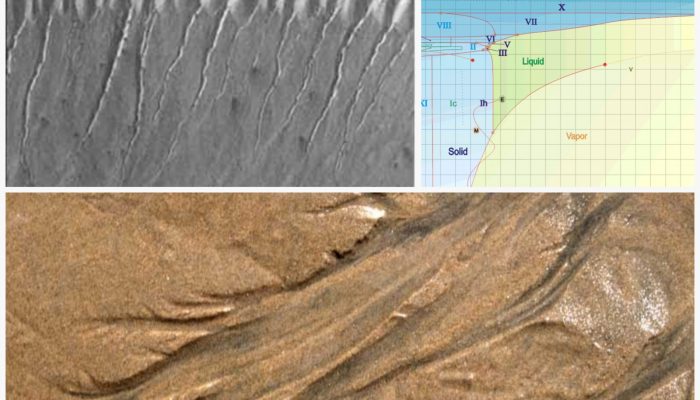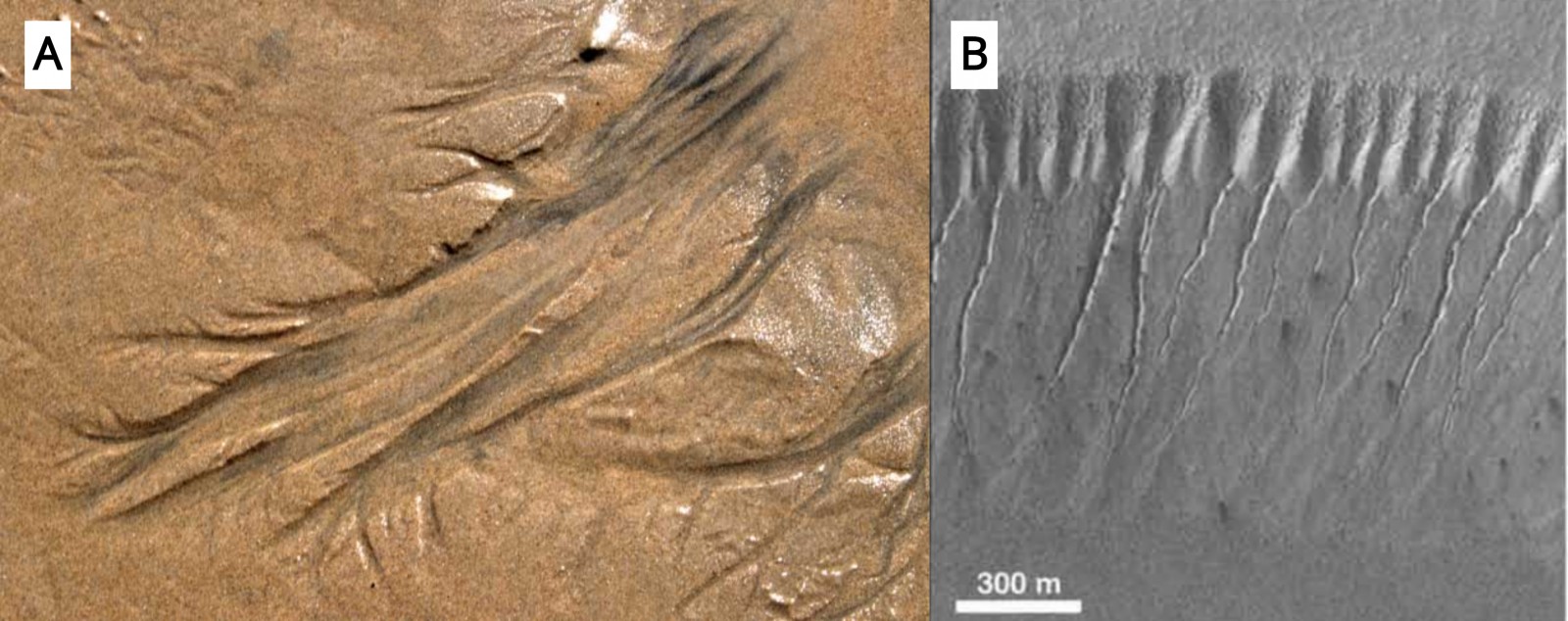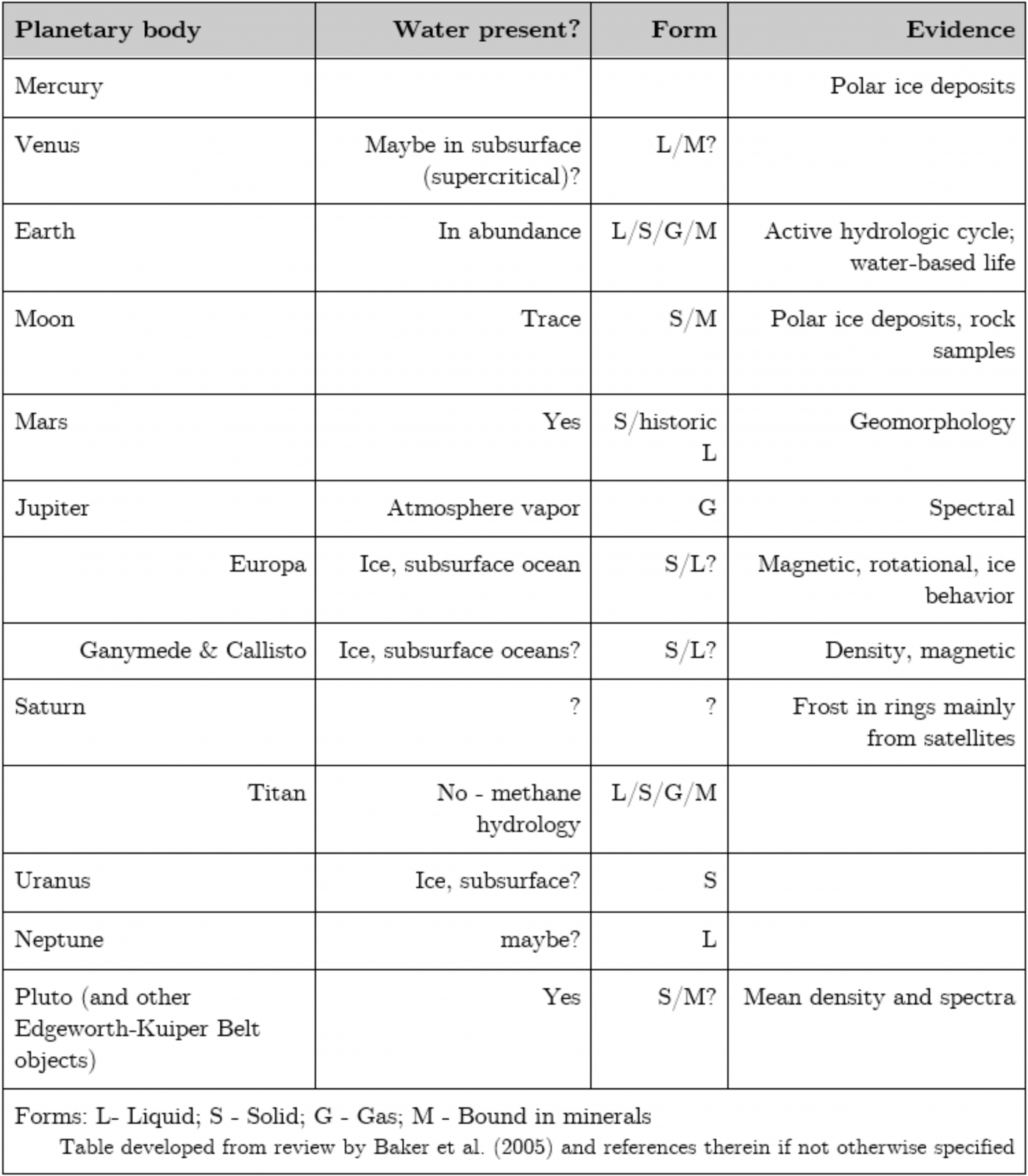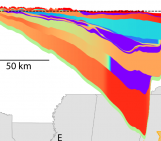
Post by Kevin Befus, Assistant Professor in Civil and Architectural Engineering at the University of Wyoming.
Have you ever taken a walk on the beach during a lowering (ebbing) tide and see mini-rivers grow and create beautiful drainage patterns before your eyes? These short-lived groundwater seepage features (Fig. 1A) are tiny (and fast) analogs of how groundwater has shaped some parts of Mars! It appears that groundwater loosening sediments can lead to all sorts of scales of erosion on both Earth and Mars.

Figure 1. A) Beach drainage pattern on the order of 1 meter (Source: https://epod.usra.edu/blog/2017/01/beach-drainage.html), B) Martian “alcoves” suggesting groundwater seepage [1].
Mars is not currently a friendly place for water to exist at the surface or even the subsurface, but an abundance of photographic and topographic evidence point to there having been the right conditions for active groundwater flow on Mars.
But isn’t Mars too cold for liquid water? The answer is generally a strong yes for the past few billion years, but amazingly enough, there appears to have been some local places where groundwater discharged to the Martian surface and left behind telltale signs.
Because Mars is cold at its land surface (mean surface temperature of -50 C with daily swings from 0 C to -100 C) with a thinner atmosphere than Earth’s, water on the Martian surface can exist as ice (as in the polar ice cap), but sublimation and evaporation would quickly wick any water near the surface. So, liquid water on Mars needs both more pressure and a good bit of heat for mobile groundwater based on the phase diagram below (circle with M shows the present day Martian surface conditions).

Figure 2. Phase diagram showing average conditions at the planetary surface for Earth (E) near the triple point, and atmospheric conditions for the frozen Mars (M) and vapor-rich Venus (V). source: http://www1.lsbu.ac.uk/water/water_phase_diagram.html#intr2; License: https://creativecommons.org/licenses/by-nc-nd/2.0/uk/)
It turns out that the most expansive evidence of liquid groundwater on Mars comes from deep at the bottom of craters (…deeper than 5 km!), where the Martian geothermal gradient (~10 C/km [Michalski et al.2013]) heats up to the point where groundwater systems, probably made up of brines, can seep across the crater walls. Without the craters, the groundwater wouldn’t have anywhere to discharge, but extraterrestrial hydrogeologists (really based on the geomorphology, but using E.T. hydrogeology principles) have identified numerous craters with groundwater seepage erosional patterns (Figure 1). The question remains open on how connected the Martian “aquifers” could be, or if the craters represent only local flow systems.
With liquid groundwater transporting the chemical-rich waters from deeper geothermal areas, the conditions could be right for supporting a deep Martian biosphere. Buried in under the Martian ice, soil, and rock microbial life could have evolved in the subterranean shelter from cosmic radiation. Groundwater flow, potentially related to geothermal conditions, could then have served as the conveyor belt for energy-rich molecules to feed microbial life in the subsurface (and still could?).
So far, Earth is the only celestial body in our solar system with an active water-hydrologic cycle, making us the lucky green planet. But, there could be a methane-based hydrologic cycle on Titan with “methanifers” as methane aquifers! For more information on extraterrestrial hydrogeology, Baker et al. (2005) provides a great overview of the planetary, lunar, and exo-planetary potential for water and groundwater, loosely summarized in this table.

At the moment, Earthlings don’t know that much yet about the paleo-hydrologic processes on Mars. But with new boots…I mean wheels…on the ground in two water-focused locations, new clues could start rolling in on Martian groundwater. The recently-arrived InSight lander will probe the Martian subsurface by drilling 5 m deep and listen for acoustic signals for even more information on the interior of Mars. The next Mars Rover is scheduled to take flight in 2020 for the Jezero Crater, where a river delta could help unravel the water-life story of Mars. And could have some groundwater surprises! At only about 1 km deep, the focus in mainly on tracking down signs of life and unravelling surface hydrologic and erosional processes on Mars, but a long list of expected outcomes does show the mission will keep an eye out for evidence of groundwater activities. Keep your feet grounded, eyes in the sky, and visions of Martian groundwater flying high and drilling low!
References [1] Malin, M. C., and K. S. Edgett (2000), Evidence for Recent Groundwater Seepage and Surface Runoff on Mars, Science, 288(5475), 2330–2335, doi:10.1126/science.288.5475.2330. [2] Michalski, J. R., J. Cuadros, P. B. Niles, J. Parnell, A. Deanne Rogers, and S. P. Wright (2013), Groundwater activity on Mars and implications for a deep biosphere, Nat. Geosci., 6(2), 133–138, doi:10.1038/ngeo1706. [3] Stofan, E. R. et al. (2007), The lakes of Titan, Nature, 445(7123), 61–64, doi:10.1038/nature05438. [4] Baker, V. R., J. M. Dohm, A. G. Fairén, T. P. A. Ferré, J. C. Ferris, H. Miyamoto, and D. Schulze-Makuch (2005), Extraterrestrial hydrogeology, Hydrogeol. J., 13(1), 51–68, doi:10.1007/s10040-004-0433-2. [5] Robinson, K. L., and G. J. Taylor (2014), Heterogeneous distribution of water in the Moon, Nat. Geosci., 7(6), 401–408, doi:10.1038/ngeo2173. [6] Jurac, S., M. A. McGrath, R. E. Johnson, J. D. Richardson, V. M. Vasyliunas, and A. Eviatar (2002), Saturn: Search for a missing water source, Geophys. Res. Lett., 29(24), 25-1-25–4, doi:10.1029/2002GL015855.
 Kevin Befus leads the groundwater hydrology group in the Civil and Architectural Engineering Department at the University of Wyoming. With his research group, he studies how groundwater systems respond to hydrologic conditions over glacial timescales and in mountainous and coastal environments. You can follow along with Kevin’s research through any of the links below:
Kevin Befus leads the groundwater hydrology group in the Civil and Architectural Engineering Department at the University of Wyoming. With his research group, he studies how groundwater systems respond to hydrologic conditions over glacial timescales and in mountainous and coastal environments. You can follow along with Kevin’s research through any of the links below:
Personal Webpage | Twitter | Research Group Page | UW Faculty Page
Keep up to date on all WaterUnderground posts by following us on our LinkedIn page! Have an idea of an intriguing post idea? We’d love to hear from you.




